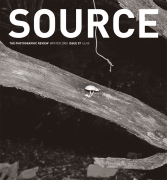Portfolio
Sarah Lynch
Issue 57 Winter 2008
View Contents ▸
Photographing Everything
I never realised talking about beauty was a problem until college. As soon as you said 'I want to make a beautiful photograph' tutors would cringe. I didn't realise it was an issue until I saw people's reaction. It's quite depressing. But if I look around and see things that are beautiful that's the word I'm going to use. 'Fragile' as well, life is hanging on the edge the entire time. We're so transient we don't exist, we're not there. That would scare the pants off some people but it's a beautiful thing for me.
Before I've even got the studio set up I sketch a lot. My sketches are a notebook of ideas that I translate into photographs. Some things are quite planned and other things are planned, fail, and something else comes after them. I use objects that I am naturally drawn to and enjoy. I collect things from everywhere, randomly. Recently the objects have become more sparse, less significant to my personal history.
For the Paper and Wire diptych, I love the way they are physically; it's the contrast between the paper and wire and the tension that holds them together as objects and then as a diptych. They are made of different materials that react in different ways, they have different histories and life-spans but have been squeezed and reformed and momentarily held into similar shapes. When you look at the ball of wire you know it would feel cold and heavy in your hand, contrasting with the lightness and fragility of the paper. I'm not doing anything clever in manipulating them, the viewer brings with them the knowledge that a gust of wind would lift the paper into the air or could push the wire along clumsily, they both have different journeys but ultimately can unravel and reveal the same thing.
Looking at the Circles, I'm trying to photograph everything without emphasising the individuality of things. We all know that a leaf is one in a million billion leaves that are almost identical. Individually it is incredibly beautiful but it's just one in a continuum of things. We see things individually but they are always part of a greater mass. These are circles that only momentarily define a space in time. The circle contains only the same space that surrounds it, and that space is identifiable only by the circle that is drawn around it. Hopefully shooting the same image with different materials is just exaggerating the point that it's the same every time.
The glass fragments broke in a haphazard way. Again, it's the objects taking on their own forms and doing their own thing. The Fragments work is different from the Circles but perhaps it's saying a similar thing; You're looking at glass but you're actually seeing reflections. It's trying to point at the transient nature of ourselves and our understanding. The reflections exist only for a brief moment. When the lights go off the reflections disappear and leave no trace. With a change of camera angle the reflections can look solid and distinct but fade out of view in another. The photograph is just recording how, in that moment of time, the light is seen reflecting off two objects. These delicate reflections are so transient that a moment later they appear differently.
I think the photographs have got better and my thought process has got clearer. I've become less obsessed with myself in the world and realised it's the world that's important and not our place in it. Ultimately, the pictures are my thoughts and personal feelings, that's all I can really express. What I am trying to show is that there is no one place that it's coming from. I'm trying to remove the emphasis on individual identity and to communicate that there really is no individual constant self. Admittedly it's a contradiction in terms and ultimately it's fruitless trying to communicate something that removes the individual because when you stand back from it, I'm only communicating what one individual is thinking. It's a dilemma.
















